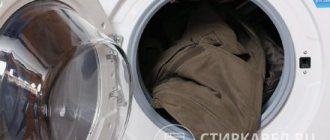Which jacket can be washed in a washing machine?
As practice shows, clothing manufacturers quite often play it safe by prohibiting washing and water cleaning. For example, washing a jacket on padding polyester, if it is not made of genuine leather, suede, silk, unsteamed cotton, is the best option for cleaning.
General washing rules:
- Check your pockets, take out everything in them, fasten zippers, buttons, snaps;
- Select delicate mode. Optimal washing of jackets in a machine requires water at 30 degrees C, the additional rinse option is turned on (otherwise soap stains will remain), the spin is turned off (to prevent deformation and creases);
- Gel or shampoo is preferable to washing powder when caring for jackets. It is much more difficult to rinse, and the likelihood of soap stains is much higher;
- Home washing of jackets with filling is carried out with two or three tennis balls. Methodically hitting the drum, they prevent bird fluff and holofiber from clumping into clumps. As a result, the clothes retain their original volume;
- After rinsing, the jacket is placed horizontally over the bathtub on a net or hung vertically on hangers. Let the water drain. Shade and natural ventilation are the best conditions for drying.
It is easy to wash a padding polyester jacket in a machine. The process can be complicated by “capricious” fittings, which are wrapped with tape for protection, or trimmed with natural fur. If the edge can be unfastened, the task is simplified. If not, then you need to carefully wrap the fur in polyethylene and secure it with tape or braid. In this form, washing a padding polyester jacket will take place without deteriorating its appearance.
IMPORTANT : You can fluff the down jacket after drying by turning on the washing machine on the spin function.
Place tennis balls in the drum; they will fluff up the natural filler in a few minutes.
Characteristics
The fiber, named after New York and London, has a structure similar to silk. The polymer material boasts a comprehensive list of positive qualities.
What does nylon fabric look like?
First of all, these include:
- high wear resistance;
- resistance to mechanical stress;
- low cost and, as a result, low pricing policy;
- good protective functions, the material is not blown through;
- thermal insulation;
- variety of shades;
- resistance to deformation;
- ease of care.
The material has negative aspects, but the number of shortcomings is far from being so impressive. The disadvantages of nylon include air tightness and instability to temperature influences.
ARTICLE FOR YOU
How to properly wash linen and flock items
Also, synthetic fibers are quite electrified and are not suitable for direct contact with the skin. You should not buy underwear or summer clothes made of polymer fabric, but the material is the most suitable for jackets or tracksuits.
Variety of nylon
Preparing and removing stains from different types of jacket fabric:
Different types of fabric and innovative materials for the top of jackets require special care. Let's look at the most popular of them.
Reflective jacket
Wash the jacket in a neutral textile gel. The use of detergents with an alkaline effect or chlorine is not allowed. It often happens that washing a jacket collar requires special attention. Treat it and other worn places with foam whipped from an aqueous solution of the gel. Leave for 20 minutes, rub with a sponge. After this, completely immerse the jacket in a cold washing solution for 30 minutes. Hand washing is recommended, allowing water to drain naturally. Machine spinning is prohibited, drying in the shade.
Water-repellent jacket
Various fabrics have these properties - bologna, synthetic fiber raincoat, membrane. Home washing of a water-repellent jacket is carried out in cold (30 degrees) water, a delicate detergent without aggressive components. It is better to take liquid or gel-like household chemicals. Washing powder clogs the pores of the membrane and leaves stains on the raincoat fabric.
Bolognese jacket
Synthetic fabric is unpretentious, water drains from it like oilcloth. Dissolve the detergent in cool water. The usual way to wash a Bolognese jacket is to soak it in a basin, rinse, and drain the water over a bathtub.
Leatherette jacket
Faux leather clothes should be washed in the same way as bologna. A cool soapy solution will wash away dirt, and rinsing several times will remove any remaining detergent. Are the water glass, lining and insulation dry? The jacket can be worn.
Membrane jackets
There is no need to wash membrane items too often. Once after the end of the ski season is enough. Water gradually washes away the special waterproof DWR impregnation. The material does not tolerate detergents containing fluorine, chlorine, or alkali. It doesn't need air conditioning. The membrane does not need to be washed with other and, especially, heavily soiled clothing. White jackets are always washed separately.
IMPORTANT : the porous structure of the membrane quickly becomes clogged with the remains of granular washing powders and dirt. This should be avoided as it is impossible to remove them from the pores.
Jean jacket
Denim is washed at temperatures up to 40 degrees. Hand and machine wash possible. Look for a clue on the product tag. Follow the manufacturer's instructions to keep your item looking like new for a long time. The temperature should not be higher than 40 degrees. The presence of chlorine in the detergent is undesirable.
Before washing, turn the jacket inside out, fasten the buttons and zipper. Amateur washing of a winter denim jacket with a fur lining is carried out according to the instructions on the tag. It is good to add conditioner when rinsing.
Basic rules for cleaning work jackets in the washing machine
It would seem that it could be easier than washing your jacket with a machine. But even here, many manage to damage the fasteners and insulation. There are several universal tips on how to wash a jacket in a washing machine so as not to deform the silhouette and use it for a long time:
Follow basic care recommendations
The label located inside the product contains data on acceptable processing modes. Sometimes manufacturers offer brochures that show different ways to clean clothes. This annotation should be kept nearby so as not to confuse anything.
Carefully study and strictly follow the manufacturer's instructions for caring for materials.
Don't forget to check your jacket for foreign objects
Before washing your jacket in the machine, be sure to take out passes, documents, bills, etc., or they will get damaged. But coins, paper clips and other metal parts can damage not only the equipment, but also the jacket. At powerful speeds, they will easily tear through pockets, lining or outer fabric.
Be sure to remove all contents from the outer and inner compartments
Run the wash in modes suitable for the materials
Before starting up the equipment, make sure that all locks and buttons are securely fastened. If you are adding a dry, powdery product to the loading container, activate the additional rinse. This is necessary to prevent soap stains. Before you wash a white jacket or a brightly colored one with a lot of metal or printing, make sure the water is not too hot. At high temperatures, the fabric may fade and even become deformed.
It is recommended to wash jackets with gel-based cleaning compounds. Unlike dry ones, they are softer and more gentle on textiles. They are much easier to rinse completely
Dry products with extreme care
Windbreakers made from lightweight fabrics can be hung up immediately. It is better to first place heavy winter jackets in a sink or on the floor on a pad to allow excess water to drain. This way you will preserve the silhouette of the item, while it will dry evenly.
You can hang your jacket on a rope or hanger only after there is no liquid left in it
Features of washing a winter jacket made from different fillers:
Sintepon is considered the most unpretentious, followed by holofiber. Natural fillers (bird down, down and feathers, wool) require delicate special care.
Washing a jacket on padding polyester
Features of synthetic winterizer: resistance to wetness and mechanical stress, lack of shrinkage and deformation. Thanks to this, there are no contraindications for delicate automatic washing of a jacket with padding polyester:
- Temperature 30 degrees C;
- Mild detergent (preferably gel or shampoo);
- Lack of aggressive components;
- Without automatic spin;
- With free flow of water, drying in the shade in the fresh air.
Washing a holofiber jacket
Jackets filled with holofiber are washed in an aqueous solution of a mild detergent at temperatures up to 40 degrees. Hand and machine washable. Things are not afraid of twisting and do not become deformed when spun in a centrifuge. Dry the washed jacket in a vertical position at natural temperature and air ventilation.
Down jacket - washable
If you have a down jacket, you can wash it by hand or in a machine. Careful preparation (checking pockets, removing fur trim, buttons and zippers closed) will ensure the desired result.
Machine version of water cleaning:
- Wash the down jacket separately, do not put anything else in the drum, add 2-4 tennis balls;
- Use liquid detergent (gel), look in the supermarket for a special series of chemicals for down products;
- For clothes with natural down, water with a temperature of no higher than 30 degrees C is suitable;
- Select a delicate wash cycle;
- Set to intensive rinse (at least two cycles);
- The spin speed should be no more than 600-800 rpm.
Washing a jacket by hand:
- Buy liquid detergent for delicate laundry;
- Remove greasy areas and stains with soap suds and a brush;
- Remove difficult stains with Vanish stain remover or other household chemicals;
- Soak the item in the soap solution for 10-15 minutes;
- Wash at temperatures up to 30 degrees C;
- Squeeze out and place over the bathtub to drain the water;
- Dry naturally on hangers.
Washing a jacket with bio-down
Bio-fluff is an artificial analogue of bird fluff. The filler is light, holds volume well, retains heat, and does not cake. Amateur washing of a jacket with bio-down is carried out manually and in a washing machine.
1. Immerse the item with the zipper (buttons) fastened and the fur trim removed in a large basin of soapy water (up to 40 degrees). Use a liquid or gel fabric cleaner. Use a clean sponge or soft brush to pre-wash the stained areas. After delicate washing and repeated rinsing, without wringing, lay the item over the bathtub on a mesh and let the water drain. Hang on hangers and dry away from heating appliances.
IMPORTANT : the detergent should not contain aggressive components.
2. Pour delicate wash gel into the container. Select temperature up to 40 degrees. Make sure that the centrifuge is set to 600 rpm, no more. Dry washed items in an upright position. Provide natural ventilation, do not dry wet clothes on heating radiators or coils.
Washing a down and feather jacket
Wash it in the same way as with natural down. Information is presented in the corresponding section of this article. Washing a winter jacket in a machine is physically easier. It is very difficult to put wet clothes in order by hand.
Rules for caring for nylon items
- Before washing, drying or ironing any item, be sure to read the label. The label will indicate which way is best to do it. He will tell you whether the items can be washed, ironed or shipped without harming the fabric. You can find the decoding of the symbols here;
- Do not wash nylon in hot water as the material will wrinkle and wrinkle. The maximum permissible washing temperature is 40 degrees;
- Nylon products should not be twisted, wrinkled or compressed too much. Light spinning is allowed in hand washing and spinning at minimum speed in machine washing;
- To bleach nylon, add bleach containing sodium perborate, but without chlorine, during washing!;
- Do not use chlorine-containing detergents for washing;
- To get rid of a yellow or gray tint on fabric, add starch during washing in a proportion of 15 grams of powder per liter of water;
- When rinsing, add conditioner to soften the water and fabric;
- To prevent lint, threads and dirt from sticking to the material, you can add an antistatic agent when rinsing;
- To dry, hang things on hangers in a well-ventilated area away from radiators and heating devices;
- It is not necessary to iron nylon, but if necessary, you can iron things at temperatures up to 110 degrees;
- Be sure to follow the care instructions on the clothing label;
- Wash nylon dyed at home the first two or three times in cool water without using bleach. By the way, it is easiest to dye white, cream and nude nylon. But dark material must first be soaked in a solvent, otherwise it will not color.
- Nylon can be dyed very easily. They do this to give a new or update an old color, to paint over scuffs and irremovable stains. Nylon is dyed in several ways. These are chemical or food dyes. The second method is more gentle and safe, but it requires more effort and time.
Drying the hammer - special attention
The best option for drying jackets is on hangers, in an upright position, in a straightened state. If you don't straighten out the creases in the fabric, it will dry out. You will have to steam or iron the jacket, which is undesirable.
The best place to dry a jacket is on the balcony, not in the sun, but in the shade. No need to use heating devices or hair dryers. After drying naturally, pat the down jacket with a carpet beater to fluff up the down. The jacket will regain its original volume.
How to wash a polyester jacket
Outerwear with synthetic fillings - padding polyester, holofiber and polyester - can be washed in water at a temperature of +40 to +50 ℃, unless otherwise indicated on the product tag.
It is advisable to use conditioner along with detergent to make the fabric soft and eliminate electrification. To prevent the filler from clumping, place several tennis balls or special laundry balls in the drum.
Choose the delicate or manual mode of operation of the washing unit, with minimum spin speed of the drum (from 400 to 500). The product must be rinsed thoroughly to remove any residual detergent from the filler. Therefore, supplement your wash program with a double rinse option.
Features of jackets of different brands
Each well-known manufacturer is trying to occupy its niche in the jacket market and offer the consumer special products. How to care for jackets from the most popular brands?
IMPORTANT : read the information on the label of the purchased clothing. Save the care instructions. This will extend the life of your favorite expensive items, and you will save on new purchases.
Columbia
If the jacket tag does not have a triangle crossed out by two straight lines, then it is machine washable:
- Remove fur trim from clothing;
- Empty your pockets of everything that is there;
- Turn the jacket inside out, fasten the buttons and zipper. You can play it safe by putting it in a special laundry bag;
- Place 2-3 clean tennis balls in the drum;
- Select the appropriate temperature setting. Branded Columbia jacket - wash at 40 degrees;
- Buy a detergent for washing down jackets. Their advantages are antistatic effect and easy rinsing;
- It is better to turn off the machine spin;
- Dry your jacket in the bathtub. Allow the water to drain completely, then hang it in a shady, ventilated place.
Machine washable
There is no need to be afraid of washing in a machine; you will definitely not ruin the product if you follow the simple instructions.
After you have read the information on the label, make sure that there is no crossed out washing icon, and pay attention to what temperature the manufacturer recommends setting.
If you don’t find any recommendations, then stick to the standard parameters: gentle mode and 30-40 degrees. One of the most effective ways to prevent damage to both the washing machine and the jacket itself is to use a special washing cover.
ATTENTION! Often people encounter the fact that white streaks form on their jacket after washing, this is especially true for black materials. This indicates that the machine did not rinse completely and the powder got stuck in the fabric. To avoid this problem, you can set the “rinse” mode again.
The question often arises, how to avoid lumps when washing jackets?
There are certain tricks that will help you in this matter. To avoid the “clumping” effect, you need to put a couple of tennis balls in the drum of the machine. In the process, he will beat the filler and it will not lose its airy properties.
It doesn’t end with washing, because the item also needs to be dried. Under no circumstances should it be hung on hangers or anywhere. Then the filler will fall down under gravity and the upper part will remain empty.
The correct way is horizontal. Lay your jacket out on a surface, ideally in the fresh air, but not in direct sunlight. As a rule, it dries within 2 days.
Note! To prevent a rotten smell from appearing, you need to turn the jacket over from time to time, then deposits will not appear.











